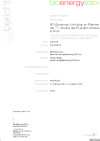Suchergebnisse
IEA Wind TCP: Annual Report 2017

Der Jahresbericht liefert Informationen zum Fortschritt der Partnerländer beim nationalen Ausbau der Windenergie sowie zu aktuellen Ergebnissen und geplanten Vorhaben in den 16 internationalen Forschungskooperationen.
Herausgeber: Executive Committee of the IEA Wind TCP, PWT Communications Inc.
Englisch, 60 Seiten
Aktuelle Berichte aus dem IEA PVPS Programm
Im IEA Photovoltaik Power Systems Programm wurden der Annual Report 2016 sowie zwei weitere Bericht veröffentlicht.
IEA Wind TCP: Annual Report 2016

Der Jahresbericht liefert Informationen zum Fortschritt der Partnerländer beim Ausbau der Windenergie sowie aktuelle Ergebnisse und geplante Vorhaben der 15 Tasks.
Herausgeber: Executive Committee of the IEA Wind Technology Collaboration Programme
Englisch, 160 Seiten
Downloads zur Publikation
Highlights 2015 – SHC Task 50 Advanced Lighting Solutions for Retrofitting Buildings

In den Highlights 2015 wird der Task 50 mit seinen Forschungsthemen im Bereich energieeffizienter Beleuchtungslösungen für die Gebäudesanierung vorgestellt. Exemplarisch werden wesentliche Ergebnisse aus dem IEA SHC Task 50 präsentiert.
Herausgeber: IEA-SHC Task 50
Englisch, 3 Seiten
Downloads zur Publikation
IEA Wind TCP: ExCo 89 Newsletter June 2022

Der Newsletter präsentiert Highlights aus Forschung und Entwicklung in den einzelnen Tasks sowie Informationen zur Entwicklung der Windkraftnutzung in den IEA Partnerländern.
Herausgeber: IEA Wind TCP ExCo, 2022
Englisch, 10 Seiten
Downloads zur Publikation
IEA Bioenergy Webinar: Integration of gasification processes in biorefineries (June 2022)

Im Rahmen der IEA Bioenergy Webinar Serie präsentierten Jitka Hrbek (BOKU) und Johannes Lindorfer (JKU Linz) die Ergebnisse der Studie. Im Anschluss standen alle Hauptautoren für Fragen zur Verfügung.
Herausgeber: IEA Bioenergy TCP, 2022
Englisch
IEA Bioenergy Webinar: An introduction to quantifying the climate effects of bioenergy

Das Webinar am 31. März 2022 behandelte die Entwicklung, Demonstration und Verfeinerung von Metriken, Methoden und Werkzeugen für die Quantifizierung von THG-Emissionen im Zusammenhang mit der Produktion und Nutzung von Bioenergie.
Herausgeber: IEA Bioenergy TCP, 2022
Englisch
IEA Wind TCP: ExCo 85 Newsletter June 2020

Im Fokus des Newsletters stehen Highlights aus Forschung und Entwicklung in den einzelnen Tasks des IEA TCP "Windenergy" sowie Informationen zur Entwicklung der Windkraftnutzung in den Partnerländern.
Herausgeber: IEA Wind TCP ExCo 85
Englisch
World Energy Outlook 2020

Der World Energy Outlook bietet einen ausführlichen Einblick, wie sich das globale Energiesystem in den kommenden Jahrzehnten entwickeln könnte. Zusätzlich zu den üblichen langfristigen Modellierungshorizonten liegt der Fokus dieses Berichts auf den nächsten zehn Jahren. Er umfasst eine detaillierte Untersuchung der Auswirkungen der Covid-19 Pandemie auf den Energiesektor und beschreibt kurzfristige Maßnahmen, welche die Energietransition beschleunigen können.
Herausgeber: IEA, 2020
Englisch
World Energy Outlook 2021

Der World Energy Outlook bietet einen ausführlichen Einblick, wie sich das globale Energiesystem in den kommenden Jahrzehnten entwickeln könnte. Diese spezielle Ausgabe soll die Entscheidungsträger:innen der COP26 und darüber hinaus unterstützen, indem sie die wichtigsten Entscheidungsfaktoren beschreibt, die den Energiesektor auf ein stabiles Fundament stellen können.
Herausgeber: IEA, 2021
Englisch
Internationale Technologie- und Marktberichte Photovoltaik

Die globalen Entwicklungen bei Markt, Produktion und Rahmenbedingungen von Photovoltaik präsentieren die jährlichen Ausgaben des "Snapshot Report" sowie des "Trends Report".
Herausgeber: IEA PVPS, Task 1
Englisch
Workshop "Biomethane"
15. April 2021
Zoom, Wien, AT
Der Workshop "Biomethan" soll die unterschiedlichen Aspekte von Biomethan bezüglich Zertifizierung, Legislative, Anwendungsbeispiele, Finanzierung und auch Forschung und neue Entwicklungen im Bereich der Methanisierung beleuchten. Neben den nationalen Beiträgen werden wichtige Umsetzungslösungen und Anwendungsbeispiele aus anderen Ländern präsentiert.
IEA PVPS Task 1: Snapshot of Global PV Markets - Edition 2021

Der Snapshot Report gibt einen Überblick über die globalen aktuellen Entwicklungen bei Markt, Produktion und Rahmenbedingungen im Jahr 2020.
Herausgeber: IEA PVPS, Task 1, Edition 2021
Englisch, 20 Seiten
Downloads zur Publikation
IEA Bioenergy News Vol. 31, #1, Juli 2019

Der Newsletter des IEA Bioenergy befasst sich mit dem ExCo83-Treffen im Mai 2019 in Utrecht, Niederlande. Außerdem enthält er einen Leitartikel zum Thema „Bioenergie in den Niederlanden“, Kurzmeldungen sowie Veröffentlichungen und Veranstaltungen.
Herausgeber: IEA Bioenergy, 2019
Englisch, 8 Seiten
Downloads zur Publikation
IEA PVPS Task 1: Snapshot of Global PV Markets 2020 Edition

Der Snapshot Report 2020 gibt einen Überblick über die aktuellen globalen Entwicklungen des Photovoltaik-Marktes, der Produktion und der Rahmenbedingungen.
Herausgeber: IEA PVPS, Task 1, Edition 2020
Englisch, 20 Seiten
IEA Bioenergy News Vol. 32, #1, Juli 2020

Diese Ausgabe befasst sich mit dem virtuellen ExCo85 Meeting. Außerdem werden die neu gestaltete Website und der grafische Auftritt von IEA Bioenergy vorgestellt. Das Noticeboard sowie aktuelle Veröffentlichungen und anstehende Veranstaltungen bilden den Abschluss des Newsletters.
Herausgeber: IEA Bioenergy, 2020
Englisch, 10 Seiten
Downloads zur Publikation
IEA Bioenergy News Vol. 33, #1, Juni 2021

Diese Ausgabe behandelt das virtuelle ExCo87-Meeting, das am 18.-19. Mai 2021 stattfand. Es enthält auch einen Überblick über den IEA-Artikel „What does net-zero emissions by 2050 mean for bioenergy and land use?“ vom Technischen Koordinator und den Aufgabenschwerpunkt von Task 43. Das Schwarze Brett sowie aktuelle Veröffentlichungen und bevorstehende Veranstaltungen bilden den Abschluss des Newsletters.
Herausgeber: IEA Bioenergy, 2021
Englisch, 10 Seiten
Downloads zur Publikation
IEA Bioenergy ExCo 77, IEA Bioenergy Workshop im Rahmen der 77. Sitzung des Exekutivkomitees in Rom am 17. Mai 2016

Dieser Bericht beinhaltet die Zusammenfassung des ExCo Meetings und des Workshops „Mobilizing Sustainable Bioenergy Supply Chains: Opportunities for Agriculture“.
Herausgeber: BIOENERGY 2020+ GmbH
Deutsch, 32 Seiten
Downloads zur Publikation
Nationaler Bioenergie Task 32 Newsletter 2016

Themenschwerpunkt im neuen nationalen Newsletter sind Biomasse Verbrennung und Mitverbrennung. Er informiert über Aktuelles aus Forschung, Implementierung und politische Maßnahmen sowie Veranstaltungen.
Christoph Schmid
Englisch
IEA SHC Task 55: Newsletter November 2016

Der Newsletter beschreibt das Kick-Off Meeting des Projektes und informiert über die nächsten Veranstaltungen. Sabine Putz, Anna Katharina Provasnek
